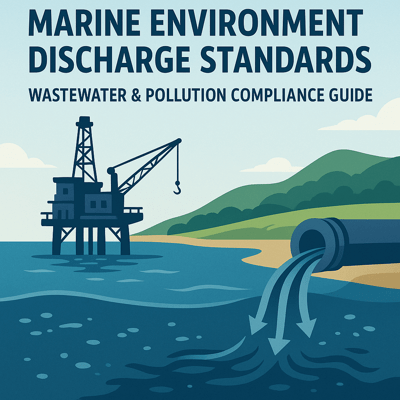Managing discharges into the marine environment is essential for safeguarding coastal and offshore ecosystems. Industries operating in these regions must comply with strict wastewater and waste disposal regulations to protect water quality and marine life. This guide highlights the key marine pollution standards, covering sewage, wastewater, solid waste, drilling fluids, and dredging activities, while emphasizing compliance with international and regional frameworks.
Understanding Marine Environment Discharge Standards
The regulatory framework for marine discharges aligns with:
- Presidency of Meteorology and Environment (PME) Document No. 1409-01
- Regional Organization for the Protection of the Marine Environment (ROPME) Protocol
- Sanitary Codes and Royal Commission Regulations
MARPOL Annex V: Prevention of Pollution by Garbage from Ships (IMO) International Maritime Organization
Facilities within Royal Commission jurisdictions of Jubail and Yanbu are subject to stricter compliance monitoring to ensure minimal ecological impact.
Regulations for Existing Facilities
Sewage and Wastewater Discharges
Facilities must comply with PME marine pollution standards (Table A), which include:
- pH: 6–9
- Total Suspended Solids (TSS): ≤ 15 mg/L
- Biochemical Oxygen Demand (BOD): ≤ 25 mg/L
- Total Coliform: ≤ 1000 MPN/100 ml
Location-based sewage requirements:
- Within 4 nautical miles, ≥10 people: Approved sewage treatment plant (STP) required.
- Within 4 nautical miles, <10 people: Sewage must be comminuted and disinfected.
- Beyond 4 nautical miles, ≥10 people: Comminution and disinfection required.
- Beyond 4 nautical miles, <10 people: Comminution only.
Grey water from accommodation platforms must be disinfected, unless exempted by the Environmental Engineering Division (EED) or Environmental Compliance Division (ECD).
Additionally:
- Discharges must not cause visible solids or water discoloration.
- In Yanbu, only untreated once-through cooling water is permitted with EED approval.
Process Design Requirements for Produced Water Treatment and Disposal at Gas-Oil Separation Plants
Solid Waste Management
- Food Waste: Prohibited within 12 nautical miles; beyond this, must be comminuted to pass a 25 mm screen.
- Plastics, paper, glass, trash: Strictly prohibited from discharge.
- Domestic Waste (offshore): Must be transported onshore for treatment in approved landfills.
- Hazardous Waste: Offshore discharge prohibited. Disposal must follow EED guidance.
Standards for New and Modified Facilities
New or modified facilities must implement Best Practical Technology (BPT) and comply with PME, ROPME, and sanitary codes. Additional requirements include:
- Submitting an Operations Instruction Manual (OIM) to the EED.
- Measuring compliance at the treatment system discharge point (no dilution allowed).
- Avoiding impacts such as bottom scour and sediment deposition.
Stricter limits apply in Royal Commission areas and biologically sensitive zones.
Drilling and Dredging Operations
Drilling Fluids
- Oil-based drilling fluids: Prohibited under ROPME, unless specifically approved by EED. Cuttings must be cleaned with BPT and discharged away from sensitive zones.
- Alternative oil-based fluids: Must pass toxicity tests (LC50).
- Water-based fluids: Must be non-toxic; cuttings cannot be discharged in sensitive ecosystems.
Dredging and Landfilling
- All dredging and reclamation discharges must comply with marine dredging standards and obtain prior approvals.
Monitoring and Compliance
Facilities must monitor effluent parameters, including:
- Daily: pH, residual chlorine
- Monthly: Total coliform levels
Data must be validated by the Environmental Compliance Division (ECD) and follow approved analytical methods. Offshore facilities with STPs are subject to regular inspection and sampling.
Special Considerations
- Royal Commission Areas (Jubail & Yanbu): Stricter limits apply (e.g., TSS ≤ 25 mg/L monthly average).
- Biologically Sensitive Areas: EED reviews discharges case-by-case.
- Slop Reception Facilities: Required at marine loading/unloading stations.
Conclusion
Discharges into the marine environment are only permitted under strict compliance with PME, ROPME, and sanitary codes. Facilities must adopt advanced treatment technologies, avoid hazardous waste disposal, and obtain approvals from the EED and ECD. By implementing best practices, industries can achieve compliance while protecting fragile marine ecosystems.

